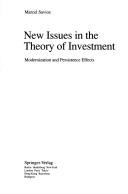| Listing 1 - 6 of 6 |
Sort by
|

ISBN: 354054979X 3642846912 9783540549796 Year: 1992 Publisher: Berlin Springer
Abstract | Keywords | Export | Availability | Bookmark
 Loading...
Loading...Choose an application
- Reference Manager
- EndNote
- RefWorks (Direct export to RefWorks)
The investment good market, together with the consumer good market, the money market and the labour market, are indeed the most extensively studied markets. The exhaustive survey of investment theory by Eisner and Strotz, already quoted four hundred references in 1963, although this work advocating for adjustment costs, was in fact only carried out at the very beginning of modern investment theory! This chapter gives an introduction of the extensive field and is an attempt to present some key ideas of investment theory. 1) We show that modern investment theory is the integration of many traditional approaches. The content of the chapter is set as follows. Section 2 presents an illustrative model of investment theory. Section 3, using this model, describes the investment decision of the firm. Sections 4 to 10 each present a "classical" investment hypothesis within the framework of the model. Section 11 concludes. For convenience, the key to the symbols used is given in Table 1. 2. The Model of the Firm Investment theory was born with the claim of Keynes (1936) that besides the capital demand (demand for a stock of capital at a point in time), an investment demand (demand for the increment of the capital stock in a period 1) Recent surveys are: Abel (1988), Coen and Eisner (1987) Artus and Muet (1984). The book on investment theory by Nickell (1978) is outstanding.
Capital investments --- Econometric models --- Soviet Union --- Economic conditions --- Finance --- Business & Economics --- Financial Management & Planning --- AA / International- internationaal --- 305.8 --- 339.312.0 --- Econometrie van de investeringen, het gedrag van de onderneming. --- Investeringen: algemeenheden. --- Capital expenditures --- Capital improvements --- Capital spending --- Fixed asset expenditures --- Plant and equipment investments --- Plant investments --- Investments --- Econometrie van de investeringen, het gedrag van de onderneming --- Investeringen: algemeenheden --- Советский Союз --- Ber. ha-M. --- Zwia̦zek Socjalistycznych Republik Radzieckich --- Szovjetunió --- TSRS --- Tarybų Socialistinių Respublikų Sąjunga --- SRSR --- Soi︠u︡z Radi︠a︡nsʹkykh Sot︠s︡ialistychnykh Respublik --- SSSR --- Soi︠u︡z Sovetskikh Sot︠s︡ialisticheskikh Respublik --- UdSSR --- Shūravī --- Ittiḥād-i Jamāhīr-i Ishtirākīyah-i Shūrāʼīyah --- Russia (1923- U.S.S.R.) --- Sovetskiy Soyuz --- Soyuz SSR --- Sovetskiĭ Soi︠u︡z --- Soi︠u︡z SSR --- Uni Sovjet --- Union of Soviet Socialist Republics --- USSR --- SSṚM --- Sovetakan Sotsʻialistakan Ṛespublikaneri Miutʻyun --- SSHM --- Sovetakan Sotsʻialistakan Hanrapetutʻyunneri Miutʻyun --- URSS --- Unión de Repúblicas Socialistas Soviéticas --- Berit ha-Moʻatsot --- Rusyah --- Ittiḥād al-Sūfiyītī --- Rusiyah --- Rusland --- Soṿet-Rusland --- Uni Soviet --- Union soviétique --- Zȯvlȯlt Kholboot Uls --- Związek Radziecki --- ESSD --- Sahaphāp Sōwīat --- KhSHM --- SSR Kavširi --- Russland --- SNTL --- PSRS --- Su-lien --- Sobhieṭ Ẏuniẏana --- FSSR --- Unione Sovietica --- Ittiḥād-i Shūravī --- Soviyat Yūniyan --- Russian S.F.S.R. --- Econometric models. --- Związek Socjalistycznych Republik Radzieckich --- ZSRR --- Związek Socjalistycznych Republik Sowieckich --- ZSRS --- Capital investments - Soviet Union - Econometric models --- Capital investments - Econometric models --- Soviet Union - Economic conditions - 1985-1991 - Econometric models

ISBN: 038754979X Year: 1992 Publisher: New York Springer
Abstract | Keywords | Export | Availability | Bookmark
 Loading...
Loading...Choose an application
- Reference Manager
- EndNote
- RefWorks (Direct export to RefWorks)
Book
Abstract | Keywords | Export | Availability | Bookmark
 Loading...
Loading...Choose an application
- Reference Manager
- EndNote
- RefWorks (Direct export to RefWorks)
Book
ISBN: 9780262046916 Year: 2022 Publisher: Cambridge (Mass.) : MIT press,
Abstract | Keywords | Export | Availability | Bookmark
 Loading...
Loading...Choose an application
- Reference Manager
- EndNote
- RefWorks (Direct export to RefWorks)
"A collection of essays addressing Karl Brunner's contributions to monetarism, and the significance of monetarism to modern macroeconomics"--
Chicago school of economics. --- Chicago school of economics. --- Macroeconomics. --- Macroeconomics. --- Macroéconomie. --- Monetary policy. --- Monetary policy. --- Political and social views. --- Politique monétaire. --- École de Chicago (Économie politique). --- Brunner, Karl, --- Brunner, Karl, --- Political and social views.
Book
ISBN: 3719018377 Year: 1999 Publisher: Basel Helbing und Lichtenhahn
Abstract | Keywords | Export | Availability | Bookmark
 Loading...
Loading...Choose an application
- Reference Manager
- EndNote
- RefWorks (Direct export to RefWorks)
Democracy --- Democracy --- Germany --- Switzerland --- Politics and government --- Politics and government
Book
Year: 2020 Publisher: Cambridge, Mass. National Bureau of Economic Research
Abstract | Keywords | Export | Availability | Bookmark
 Loading...
Loading...Choose an application
- Reference Manager
- EndNote
- RefWorks (Direct export to RefWorks)
We construct recursive solutions for, and study the properties of the dynamic equilibrium of an economy with three types of agents: (i) house-hold/investors who supply labor with a finite elasticity, consume a large variety of goods that are not perfect substitutes and trade government bonds; (ii) firms that produce those varieties of goods, receive productivity shocks and set prices in a Calvo manner; (iii) a government that collects an income-driven fiscal surplus and acts mechanically, buying and selling bonds in accordance with a Taylor policy rule based on expected inflation. In this setting we show that stock market returns are much less than one-for-one related to inflation over a one-year holding period, which means that stock securities have a strong nominal character. We also show that their nominal character diminishes as the length of the stock-holding period increases, in accordance with empirical evidence.
| Listing 1 - 6 of 6 |
Sort by
|

 Search
Search Feedback
Feedback About UniCat
About UniCat  Help
Help News
News